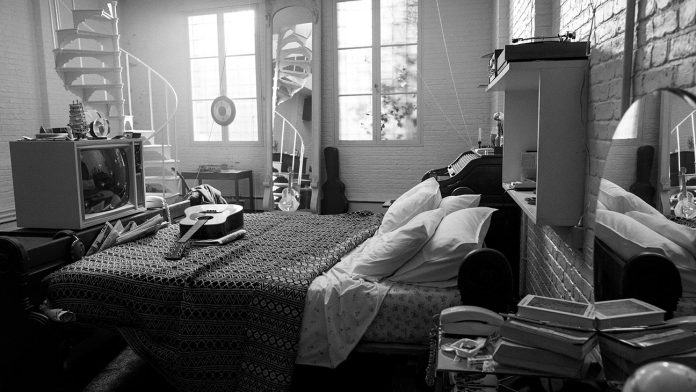The bond between John Lennon and Yoko Ono, mutually inspired artists from very different worlds, is only one of the love stories at the core of director Kevin Macdonald’s vibrant and stirring new documentary. Tracing an eventful year, One to One: John & Yoko is, first and foremost, a portrait of the couple’s love affair with New York City, their newly adopted home. In its mix of remarkable archival material, the film is both tender and galvanizing, summoning up what New York felt like in 1972 (yes, I would know) and offering a fresh slant on a country’s upheaval and a generation’s countercultural awakening.
For Macdonald (One Day in September, The Last King of Scotland), One to One is not only a return to form after his mixed-bag profile of John Galliano, but one of his finest pieces of work. He and co-director/editor Sam Rice-Edwards have conjured a you-are-there energy from an extraordinary selection of existing material. With one key exception — the reconstruction of Lennon and Ono’s rented Greenwich Village apartment, finely detailed by production designer Kevin Timon Hill and set decorator Tatiana Macdonald, and evocatively shot by cinematographer David Katznelson — the feature consists entirely of audio and video from personal and public archives.
One to One: John & Yoko
The Bottom Line
A stone-cold brilliant fusion of kinetic and contemplative.
Venue: Venice Film Festival (Out of Competition)
Director: Kevin Macdonald
Co-director/editor: Sam Rice-Edwards
1 hour 41 minutes
At the center of the curated material is restored footage of One to One, the August 1972 concert the couple organized and headlined to benefit the children of Staten Island’s Willowbrook institution. The Madison Square Garden show’s original camerawork is intimate and compelling, and John and Yoko’s son, Sean Ono Lennon, has produced a superb sound remix.
When Lennon and Ono left their estate in England for a small apartment on Bank Street and the chance to hobnob with “artists and political radicals,” as one of the movie’s judiciously used explanatory title cards puts it, the Attica uprising was recent news, Nixon was seeking a second term and the antiwar movement was strong. On a radio call-in show, Lennon talks about how at home he feels in the city — an exuberant declaration that couldn’t be more poignant, given that New York would be the place of his 1980 murder. Later, on the phone, the renowned drummer Jim Keltner shares his qualms about playing fundraisers with a political message. He fears violent reactions, to which Lennon replies, “I’m not about to get myself shot.”
As One to One illustrates with verve and sensitivity, Lennon considered himself a revolutionary artist and was often in sync with cultural radicals and the antiwar left. But just as clear is his refusal to toe any party line. One of the key figures he befriended and worked with — until he found reason to break away — was the highly theatrical Jerry Rubin, co-founder of the Yippies and one of the Chicago Seven. Whatever you think of Rubin, in this age of dime-a-dozen “icons,” we sorely need an iconoclast or two.
Also in the circle of New York activists at the time was the mildly goofy and weirdly contentious “Dylanologist” and Rock Liberation Front co-founder A.J. Weberman, who pored through Bob Dylan’s garbage on a purist’s mission to prove the depths of his onetime hero’s betrayal. “He’s doing a whole capitalist number,” Weberman rails to Ono in one of several fascinating exchanges excerpted in the documentary. “He’s become the enemy,” he insists, while she tries to broker a peace deal.
During the whirlwind of their first year and a half in Manhattan, before they moved uptown to the Dakota, Ono and Lennon were not just befriending scenesters but also busy working — he on music, she on music, films and conceptual art. They were additionally trying to regain contact with Ono’s daughter from her first marriage, dealing with tapped phones and facing the threat of deportation because of a pot bust in the U.K.
And, in their Village apartment, they watched a lot of TV.
Macdonald and Rice-Edwards intercut flashes of the small-screen fare and commercials the couple might have seen on the set in their bedroom — Mary Tyler Moore, Tony the Tiger, the miracle of Tupperware, car ads adorned by the apparently necessary participation of scantily clad women. In the filmmakers’ hands, what might have seemed clichéd pulses instead with life and irony, propelled by a heartbeat-precise musicality. There are also piercing scenes of the disastrous war in Vietnam, the kind of reports that blanketed the evening news with images of bombs falling, villages burning, children crying and American soldiers on a seemingly endless and doomed mission.
Lennon and Ono made notable TV appearances, too, on the shows of Dick Cavett and Mike Douglas, cultural gems that gave people the chance to actually converse and that put today’s late night and cable yakkers to withering shame. (Their week as co-hosts of The Mike Douglas Show is itself the subject of an upcoming documentary, Daytime Revolution.)
Macdonald doesn’t supply onscreen titles to ID people. Some are easily deduced amid the quick-moving cavalcade, including Billy Graham, Bob Hope, Jane Fonda, Betty Friedan and Arthur Janov; others might require you to do the research or ask your mother. Even when the names of unseen telephone callers appear onscreen, their job titles or roles are not usually supplied, though the graphic treatment of these convos is otherwise crisp and effective. A running joke concerns discussions about the need to procure many flies for an Ono art project and involves May Pang. You either know or you don’t that she was at the time a personal assistant to the couple, and that she would, as recently explored in The Lost Weekend, become romantically involved the following year with Lennon at Ono’s urging.
Among the thrilling moments we get to see is the gutsy antiwar protest of Carole Feraci, one of the otherwise corny Ray Conniff Singers, at a gala in the Nixon White House. Less thrilling but providing a certain wink-wink factor are clips of a dark-haired Phil Donahue enduring a ranting Rubin and a long-haired Leslie Stahl talking about Watergate on the evening news. But the journalist who really makes an impression here is local ABC reporter John Johnson, seen on-site at Attica, shaken and recovering from tear gas, and on the streets of Manhattan’s Little Italy to gauge neighbors’ reaction to the gangland murder of Joey Gallo (whom Dylan would later eulogize in song). His is a kind of TV reporting that’s rarely, if ever, seen anymore.
Through its kaleidoscopic but very specific lens, the film illuminates a seismic generational shift. Lennon, barely in his 30s and a leading figure of the postwar generation, is at first jazzed about embarking on a Free the People project with Rubin — a concert tour aiming to raise bail money for American prisoners who couldn’t afford to pay the fees. For understandable reasons, he changes his mind and backs out. And he turns his focus more inward.
“The hardest thing is facing yourself,” Lennon tells an unnamed journalist. He’s expressing a universal truth but also signaling, in Macdonald’s astute telling, the pivot that many older baby boomers would make through such trends as primal therapy. To the helmer’s credit, he doesn’t fall into hackneyed and jokey “Me Generation” tropes but follows this quest for self-understanding to a place of compassion. For a real gut punch of loving kindness, consider his inclusion of the response by Shirley Chisholm, who achieved many American firsts as a Black female politician, to the shooting of another presidential candidate, avowed segregationist George Wallace.
One of the most shocking things to appear on television in 1972 was Geraldo Rivera’s Willowbrook exposé; even the doc’s brief excerpts from his report, revealing the enormous facility’s inhumane warehousing of children with mental disabilities, are harrowing. For Lennon, the kids at Willowbrook were “almost symbolic of all the pain on Earth,” and he and Ono set out to help them with One to One, his only full-length post-Beatles concert. In footage of the benefit show, he looks and sounds energized. The band is blistering, whether covering “Hound Dog” or backing him on “Instant Karma” and “Come Together.” And when, at the keyboard, he sings “Imagine,” whose lyrics encapsulate a vision of peace as idealistic as any ever put to music, that tear on his cheek comes as a jolt from this figure of effortless charm and Liverpudlian humor.
There’s an urgent question at the heart of Macdonald’s documentary: Was all that apathy-fighting hope and activism naive? Conversely, have we sunk so low that the idea of giving peace a chance, of envisioning a world where there’s “nothing to kill or die for,” is something to file under “Dated”? As the prevailing winds of war, corporate greed and censorship reach gale-force speed, and as sloganeering and posturing offer pathetic substitutes for openheartedness and true justice, One to One is a reminder of the future we kids imagined in 1972. It’s also an act of encouragement. Lennon put it well when he told a concert audience, “OK, so flower power didn’t work. So what? We start again.” Here’s to that.







